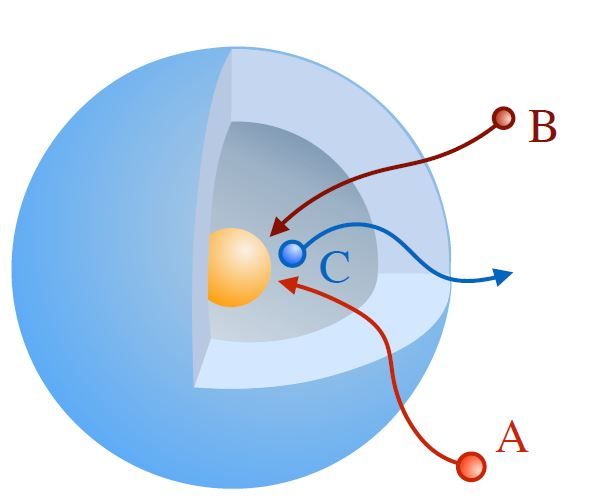New model for bimolecular reactions in nanoreactors
Theoretical physicists have devised a mathematical model of two different molecules reacting within so called nanoreactors that act as catalysts. They gained surprising new insights as to what factors promote reactions and how to control and select them. The model is relevant for a wide range of research fields, from biophysics to energy materials.

Sketch of an yolk-shell-type nanoreactor: reactands A and B diffuse through the shell and react to C at the catalytically active nanoparticle (yellow).
HZB
Nanoreactors are tiny systems which facilitate specific chemical reactions, as a catalyst does. Many are found in biological systems, such as certain proteins. But chemists are also able to synthesise artificial nanoreactors to control chemical reactions. An important class of these nanoreactors has a “yolk & shell” architecture like an egg: a catalytically active metallic nanoparticle is surrounded by a shell consisting of a polymeric network. These kinds of nanoreactors can create isolated environments for specific reactions and restrict them to the tiny space inside the shell.
Mathematical description delivers new insights
“We have now mathematically described for the first time how two different molecules are transported to react within nanoreactors. The new model shows clearly what factors favour a given reaction“, says Dr. Rafael Roa. Roa is first author of the publication in ACS Catalysis and a postdoc in the group headed by Prof. Joe Dzubiella at the HZB Institute for Soft Matter and Functional Materials.
What matters most?
Some of the results come as a surprise: contrary to expectations, the reaction rate is not so much limited by the concentration of the molecules in solution, but decisively by the permeability of the nanoreactor’s shell. ”This is extremely interesting since chemists today can often fine tune or even switch the permeability of these shells to specific molecules via variations in temperature or other parameters“, explains co-author Dr. Won Kyu Kim.
Photo-activation taken into account
The new model is a big step forward from the older theory done many decades earlier that could handle only one molecule. ”Our model is applicable to research on energy materials, and it can even take into account photo-activation of one of the molecules at the shell by sunlight“, Dzubiella states. He has achieved with this work one of the goals of his European Research Council (ERC) Consolidator Grant (2015-2020).
Predictions will be put to test
Dzubiella’s Soft Matter Theory group collaborates with HZB chemist Prof. Yan Lu, an acknowledged expert in synthetic nanoreactors. They are eager to test their theoretical predictions on real systems. “We’re now able to better understand what happens, and we expect to predict how the catalytic effects of these types of nanoreactors can be controlled – through feedback loops, for instance, which will stop or start the reaction at will.“
Original publication
Other news from the department science

Get the chemical industry in your inbox
By submitting this form you agree that LUMITOS AG will send you the newsletter(s) selected above by email. Your data will not be passed on to third parties. Your data will be stored and processed in accordance with our data protection regulations. LUMITOS may contact you by email for the purpose of advertising or market and opinion surveys. You can revoke your consent at any time without giving reasons to LUMITOS AG, Ernst-Augustin-Str. 2, 12489 Berlin, Germany or by e-mail at revoke@lumitos.com with effect for the future. In addition, each email contains a link to unsubscribe from the corresponding newsletter.




























































